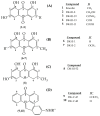Is Emodin with Anticancer Effects Completely Innocent? Two Sides of the Coin
- PMID: 34073059
- PMCID: PMC8198870
- DOI: 10.3390/cancers13112733
Is Emodin with Anticancer Effects Completely Innocent? Two Sides of the Coin
Abstract
Many anticancer active compounds are known to have the capacity to destroy pathologically proliferating cancer cells in the body, as well as to destroy rapidly proliferating normal cells. Despite remarkable advances in cancer research over the past few decades, the inclusion of natural compounds in researches as potential drug candidates is becoming increasingly important. However, the perception that the natural is reliable is an issue that needs to be clarified. Among the various chemical classes of natural products, anthraquinones have many biological activities and have also been proven to exhibit a unique anticancer activity. Emodin, an anthraquinone derivative, is a natural compound found in the roots and rhizomes of many plants. The anticancer property of emodin, a broad-spectrum inhibitory agent of cancer cells, has been detailed in many biological pathways. In cancer cells, these molecular mechanisms consist of suppressing cell growth and proliferation through the attenuation of oncogenic growth signaling, such as protein kinase B (AKT), mitogen-activated protein kinase (MAPK), HER-2 tyrosine kinase, Wnt/-catenin, and phosphatidylinositol 3-kinase (PI3K). However, it is known that emodin, which shows toxicity to cancer cells, may cause kidney toxicity, hepatotoxicity, and reproductive toxicity especially at high doses and long-term use. At the same time, studies of emodin, which has poor oral bioavailability, to transform this disadvantage into an advantage with nano-carrier systems reveal that natural compounds are not always directly usable compounds. Consequently, this review aimed to shed light on the anti-proliferative and anti-carcinogenic properties of emodin, as well as its potential toxicities and the advantages of drug delivery systems on bioavailability.
Keywords: anthraquinone; apoptosis; cancer; drug discovery; emodin; nano-drug delivery.
Conflict of interest statement
The authors declare that they have no known competing financial interest or personal relationships that could have appeared to influence the work reported in this paper.
Figures













Similar articles
-
Advances in Understanding the Role of Aloe Emodin and Targeted Drug Delivery Systems in Cancer.Oxid Med Cell Longev. 2022 Jan 18;2022:7928200. doi: 10.1155/2022/7928200. eCollection 2022. Oxid Med Cell Longev. 2022. PMID: 35087619 Free PMC article. Review.
-
Anticancer action of naturally occurring emodin for the controlling of cervical cancer.Explor Target Antitumor Ther. 2023;4(4):690-698. doi: 10.37349/etat.2023.00161. Epub 2023 Aug 31. Explor Target Antitumor Ther. 2023. PMID: 37720346 Free PMC article. Review.
-
Emodin - A natural anthraquinone derivative with diverse pharmacological activities.Phytochemistry. 2021 Oct;190:112854. doi: 10.1016/j.phytochem.2021.112854. Epub 2021 Jul 24. Phytochemistry. 2021. PMID: 34311280 Review.
-
The distinct mechanisms of the antitumor activity of emodin in different types of cancer (Review).Oncol Rep. 2013 Dec;30(6):2555-62. doi: 10.3892/or.2013.2741. Epub 2013 Sep 19. Oncol Rep. 2013. PMID: 24065213 Review.
-
The versatile emodin: A natural easily acquired anthraquinone possesses promising anticancer properties against a variety of cancers.Int J Biol Sci. 2022 May 16;18(8):3498-3527. doi: 10.7150/ijbs.70447. eCollection 2022. Int J Biol Sci. 2022. PMID: 35637953 Free PMC article. Review.
Cited by
-
Trichopus zeylanicus ameliorates ibuprofen inebriated hepatotoxicity and enteropathy: an insight into its modulatory impact on pro/anti-inflammatory cytokines and apoptotic signaling pathways.Inflammopharmacology. 2022 Dec;30(6):2229-2242. doi: 10.1007/s10787-022-01052-5. Epub 2022 Aug 25. Inflammopharmacology. 2022. PMID: 36008576 Free PMC article.
-
Majoon Chobchini attenuates arthritis disease severity and RANKL-mediated osteoclastogenesis in rheumatoid arthritis.3 Biotech. 2021 Oct;11(10):436. doi: 10.1007/s13205-021-02985-4. Epub 2021 Sep 17. 3 Biotech. 2021. PMID: 34549015 Free PMC article.
-
Oxidative Stress Inducers in Cancer Therapy: Preclinical and Clinical Evidence.Antioxidants (Basel). 2023 May 26;12(6):1159. doi: 10.3390/antiox12061159. Antioxidants (Basel). 2023. PMID: 37371889 Free PMC article. Review.
-
New Approaches on Japanese Knotweed (Fallopia japonica) Bioactive Compounds and Their Potential of Pharmacological and Beekeeping Activities: Challenges and Future Directions.Plants (Basel). 2021 Nov 29;10(12):2621. doi: 10.3390/plants10122621. Plants (Basel). 2021. PMID: 34961091 Free PMC article. Review.
-
Expression of EGFRvIII and its co‑expression with wild‑type EGFR, or putative cancer stem cell biomarkers CD44 or EpCAM are associated with poorer prognosis in patients with hepatocellular carcinoma.Oncol Rep. 2024 Dec;52(6):172. doi: 10.3892/or.2024.8831. Epub 2024 Oct 25. Oncol Rep. 2024. PMID: 39450530 Free PMC article.
References
-
- Arcamone F., Penco S. In: Anthracycline and Anthracenedione-Based Anticancer Agents. Lown J.W., editor. Elsevier; Amsterdam, The Netherlands: 1988.
Publication types
LinkOut - more resources
Full Text Sources
Research Materials
Miscellaneous

